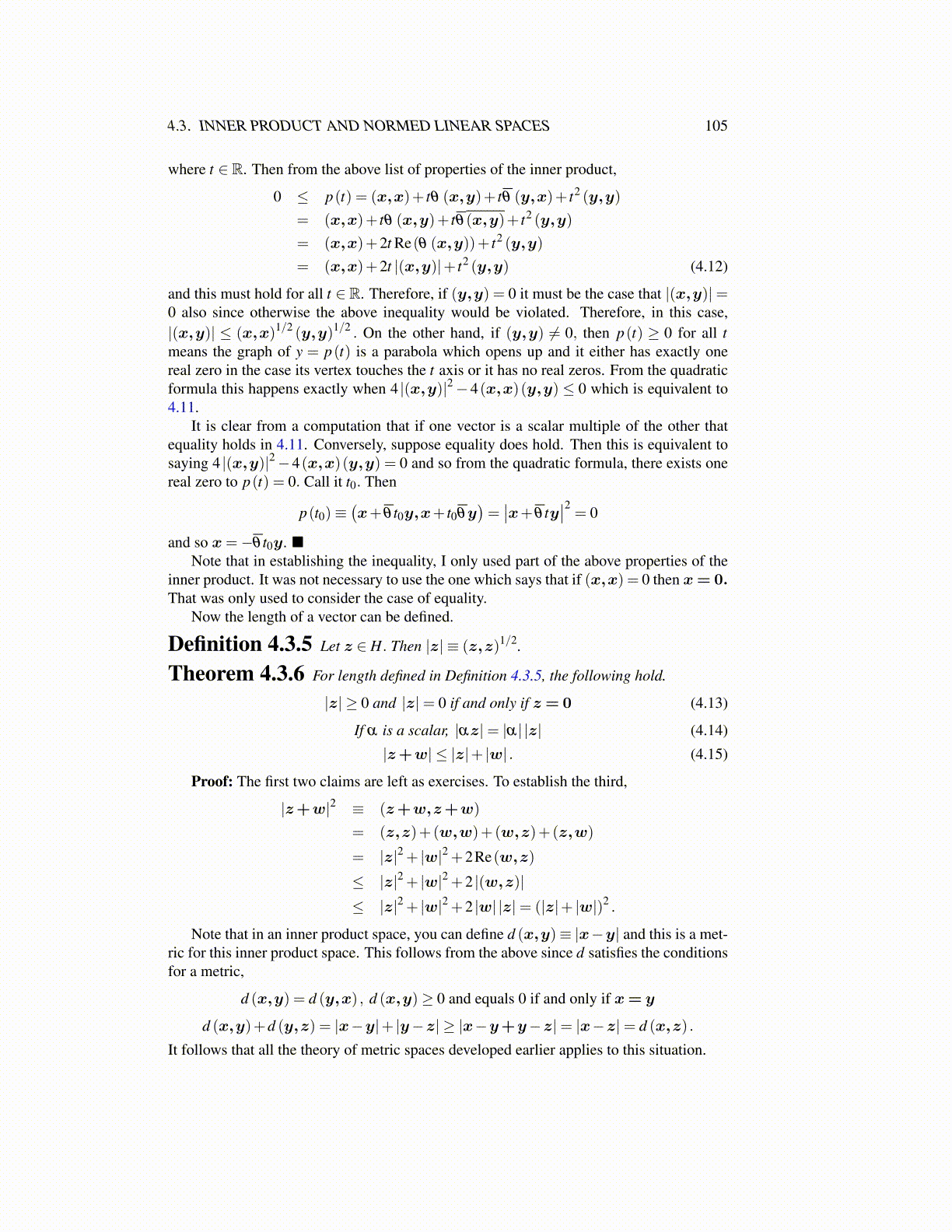
4.3. INNER PRODUCT AND NORMED LINEAR SPACES 105
where t ∈ R. Then from the above list of properties of the inner product,
0 ≤ p(t) = (x,x)+ tθ (x,y)+ tθ (y,x)+ t2 (y,y)
= (x,x)+ tθ (x,y)+ tθ(x,y)+ t2 (y,y)
= (x,x)+2t Re(θ (x,y))+ t2 (y,y)
= (x,x)+2t |(x,y)|+ t2 (y,y) (4.12)
and this must hold for all t ∈ R. Therefore, if (y,y) = 0 it must be the case that |(x,y)|=0 also since otherwise the above inequality would be violated. Therefore, in this case,|(x,y)| ≤ (x,x)1/2 (y,y)1/2 . On the other hand, if (y,y) ̸= 0, then p(t) ≥ 0 for all tmeans the graph of y = p(t) is a parabola which opens up and it either has exactly onereal zero in the case its vertex touches the t axis or it has no real zeros. From the quadraticformula this happens exactly when 4 |(x,y)|2− 4(x,x)(y,y) ≤ 0 which is equivalent to4.11.
It is clear from a computation that if one vector is a scalar multiple of the other thatequality holds in 4.11. Conversely, suppose equality does hold. Then this is equivalent tosaying 4 |(x,y)|2−4(x,x)(y,y) = 0 and so from the quadratic formula, there exists onereal zero to p(t) = 0. Call it t0. Then
p(t0)≡(x+θ t0y,x+ t0θy
)=∣∣x+θ ty
∣∣2 = 0
and so x=−θ t0y. ■Note that in establishing the inequality, I only used part of the above properties of the
inner product. It was not necessary to use the one which says that if (x,x) = 0 then x= 0.That was only used to consider the case of equality.
Now the length of a vector can be defined.
Definition 4.3.5 Let z ∈ H. Then |z| ≡ (z,z)1/2.
Theorem 4.3.6 For length defined in Definition 4.3.5, the following hold.
|z| ≥ 0 and |z|= 0 if and only if z= 0 (4.13)
If α is a scalar, |αz|= |α| |z| (4.14)
|z+w| ≤ |z|+ |w| . (4.15)
Proof: The first two claims are left as exercises. To establish the third,
|z+w|2 ≡ (z+w,z+w)
= (z,z)+(w,w)+(w,z)+(z,w)
= |z|2 + |w|2 +2Re(w,z)
≤ |z|2 + |w|2 +2 |(w,z)|≤ |z|2 + |w|2 +2 |w| |z|= (|z|+ |w|)2 .
Note that in an inner product space, you can define d (x,y)≡ |x−y| and this is a met-ric for this inner product space. This follows from the above since d satisfies the conditionsfor a metric,
d (x,y) = d (y,x) , d (x,y)≥ 0 and equals 0 if and only if x= y
d (x,y)+d (y,z) = |x−y|+ |y−z| ≥ |x−y+y−z|= |x−z|= d (x,z) .
It follows that all the theory of metric spaces developed earlier applies to this situation.